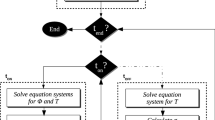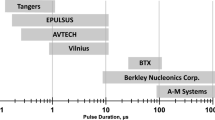Abstract
Electrotransfer (electroporation) is recognized as one of the most promising alternatives to viral vectors for transfection of different tissues in vivo for therapeutic purposes. We evaluated the transfection efficiency of reporter genes (green fluorescent protein and luciferase) in murine subcutaneous tumors using different combinations of high-field (HV) (600–1400 V cm−1, 100 μs, 8 pulses) and low-field (LV) (80–160 V cm−1, 50–400 ms, 1–8 pulses) pulses and compared it to protocol using eight identical pulses of 600 V cm−1 and 5 ms duration (electro-gene therapy, EGT). Expression of GFP was determined using a fluorescent microscope and flow cytometry and expression of luciferase by measuring its activity using a luminometer. The EGT protocol yielded the highest expression of both reporter genes. However, a careful optimization of combinations of HV and LV pulses may result in similar transfection as EGT pulses. With the combination protocol, relatively high fields of LV pulses were necessary to obtain comparable transfection to the EGT protocol. Expression of reporter genes was higher in B16 melanoma than in SA-1 fibrosarcoma. Our data support the hypothesis that both electropermeabilization and electrophoresis are involved in electrotransfer of plasmid DNA, but demonstrate that these components have to happen at the same time to obtain significant expression of the target gene in tumors.
This is a preview of subscription content, access via your institution
Access options
Subscribe to this journal
Receive 12 print issues and online access
$259.00 per year
only $21.58 per issue
Buy this article
- Purchase on Springer Link
- Instant access to full article PDF
Prices may be subject to local taxes which are calculated during checkout







Similar content being viewed by others
References
Neumann E, Schaefer-Ridder M, Wang Y, Hofschneider PH . Gene transfer into mouse lyoma cells by electroporation in high electric fields. EMBO J 1982; 1: 841–845.
Titomirov AV, Sukharev S, Kistanova E . In vivo electroporation and stable transformation of skin cells of newborn mice by plasmid DNA. Biochim Biophys Acta 1991; 1088: 131–134.
Isaka Y, Imai E . Electroporation-mediated gene therapy. Expert Opin Drug Deliv 2007; 4: 561–571.
Cemazar M, Golzio M, Sersa G, Rols MP, Teissié J . Electrically-assisted nucleic acids delivery to tissues in vivo: where do we stand? Curr Pharm Des 2006; 12: 3817–3825.
Henshaw JW, Yuan F . Field distribution and DNA transport in solid tumors during electric field-mediated gene delivery. J Pharm Sci 2008; 97: 691–711.
Heller LC, Heller R . In vivo electroporation for gene therapy. Hum Gene Ther 2006; 17: 890–897.
Prud'homme GJ, Glinka Y, Khan AS, Draghia-Akli R . Electroporation-enhanced nonviral gene transfer for the prevention or treatment of immunological, endocrine and neoplastic diseases. Curr Gene Ther 2006; 6: 243–273.
Cemazar M, Sersa G . Electrotransfer of therapeutic molecules into tissues. Curr Opin Mol Ther 2007; 9: 554–562.
Daud AI, DeConti RC, Andrews S, Urbas P, Riker AI, Sondak VK et al. Phase I trial of interleukin-12 plasmid electroporation in patients with metastatic melanoma. J Clin Oncol 2008; 26: 5896–5903.
Rols MP, Delteil C, Golzio M, Dumond P, Cros S, Teissié J . In vivo electrically mediated protein and gene transfer in murine melanoma. Nat Biotechnol 1998; 16: 168–171.
Bettan M, Ivanov MA, Mir LM, Boissière F, Delaere P, Scherman D . Efficient DNA electrotransfer into tumors. Bioelectrochemistry 2000; 52: 83–90.
Cemazar M, Sersa G, Wilson J, Tozer GM, Hart SL, Grosel A et al. Effective gene transfer to solid tumours using different non-viral gene delivery techniques: electroporation, liposomes and integrin-targeted vector. Cancer Gene Ther 2002; 9: 399–406.
Aihara H, Miyazaki J . Gene transfer into muscle by electroporation in vivo. Nat Biotechnol 1998; 16: 867–870.
Niu G, Heller R, Catlett-Falcone R, Coppola D, Jaroszeski M, Dalton W et al. Gene therapy with dominant-negative Stat3 suppresses growth of the murine melanoma B16 tumor in vivo. Cancer Res 1999; 59: 5059–5063.
Lucas ML, Heller R . IL-12 gene therapy using an electrically mediated nonviral approach reduces metastatic growth of melanoma. DNA Cell Biol 2003; 22: 755–763.
Lucas ML, Heller L, Coppola D, Heller R . IL-12 plasmid delivery by in vivo electroporation for the successful treatment of established subcutaneous B16.F10 melanoma. Mol Ther 2002; 5: 668–675.
Bureau MF, Gehl J, Deleuze V, Mir LM, Scherman D . Importance of association between permeabilization and electrophoretic forces for intramuscular DNA electrotransfer. Biochim Biophys Acta 2000; 1474: 353–359.
Andre FM, Gehl J, Sersa G, Preat V, Hojman P, Eriksen J et al. Efficiency of high and low voltage pulse combinations for gene electrotransfer in muscle, liver, tumor and skin. Hum Gene Ther 2008; 19: 1261–1271.
Satkauskas S, Bureau MF, Puc M, Mahfoudi A, Scherman D, Miklavcic D et al. Mechanisms of in vivo DNA electrotransfer: respective contributions of cell electropermeabilization and DNA electrophoresis. Mol Ther 2002; 5: 133–140.
Pavselj N, Preat V . DNA electrotransfer into the skin using a combination of one high- and one low-voltage pulse. J Control Release 2005; 106: 407–415.
Vandermeulen G, Staes E, Vanderhaeghen ML, Bureau MF, Scherman D, Préat V . Optimisation of intradermal DNA electrotransfer for immunisation. J Control Release 2007; 4: 81–87.
Tevz G, Pavlin D, Kamensek U, Kranjc S, Mesojednik S, Coer A et al. Gene electrotransfer into murine skeletal muscle: a systematic analysis of parameters for long-term gene expression. Technol Cancer Res Treat 2008; 7: 91–102.
Pavlin D, Tozon N, Sersa G, Pogacnik A, Cemazar M . Efficient electrotransfection into canine muscle. Technol Cancer Res Treat 2008; 7: 45–54.
Valic B, Golzio M, Pavlin M, Schatz A, Faurie C, Gabriel B et al. Effect of electric field induced transmembrane potential on spheroidal cells: theory and experiment. Eur Biophys J 2003; 32: 519–528.
Faurie C, Golzio M, Moller P, Teissie J, Rols MP . Cell and animal imaging of electrically mediated gene transfer. DNA Cell Biol 2003; 22: 777–783.
Mesojednik S, Pavlin D, Sersa G, Coer A, Kranjc S, Grosel A et al. The effect of the histological properties of tumors on transfection efficiency of electrically assisted gene delivery to solid tumors in mice. Gene Therapy 2007; 14: 1261–1269.
Liu F, Heston S, Shollenberger LM, Sun B, Mickle M, Lovell M et al. Mechanism of in vivo DNA transport into cells by electroporation: electrophoresis across the plasma membrane may not be involved. J Gene Med 2006; 8: 353–361.
Zaharoff DA, Henshaw JW, Mossop B, Yuan F . Mechanistic analysis of electroporation-induced cellular uptake of macromolecules. Exp Biol Med 2008; 233: 94–105.
Cashman JP, Larkin JO, Casey G, Whelan MC, Collins C, Aarons S et al. Immune gene therapy as a neoadjuvant to surgical excision to control metastatic cancers. Cancer Lett 2008; 262: 94–102.
Pucihar G, Kotnik T, Teissié J, Miklavcic D . Electropermeabilization of dense cell suspensions. Eur Biophys J 2007; 36: 173–185.
Zaharoff DA, Barr RC, Li CY, Yuan F . Electromobility of plasmid DNA in tumor tissues during electric field-mediated gene delivery. Gene Therapy 2002; 9: 1286–1290.
Zupanic A, Ribaric S, Miklavcic D . Increasing the repetition frequency of electric pulse delivery reduces unpleasant sensations that occur in electrochemotherapy. Neoplasma 2007; 54: 246–250.
Satkauskas S, Andre F, Bureau MF, Scherman D, Miklavcic D, Mir LM . Electrophoretic component of electric pulses determines the efficacy of in vivo DNA electrotransfer. Hum Gene Ther 2005; 16: 1194–1201.
Pavselj N, Miklavcic D . Numerical modeling in electroporation-based biomedical applications. Radiol Oncol 2008; 42: 159–168.
Mossop BJ, Barr RC, Henshaw JW, Zaharoff DA, Yuan F . Electric fields in tumors exposed to external voltage sources: implication for electric field-mediated drug and gene delivery. Ann Biomed Eng 2006; 34: 1564–1572.
Henshaw JW, Zaharoff DA, Mossop BJ, Yuan F . Electric field-mediated transport of plasmid DNA in tumor interstitium in vivo. Bioelectrochemistry 2007; 71: 233–242.
Acknowledgements
This work was supported by the Association Française des Myopathies, the Ligue Francaise contre le Cancer, the CNRS–CEA joint program (Imagerie du petit animal) and the Slovenian Research Agency (project nos. P3-0003 and J3-7044), and the European Commission's 5th Framework Program (Cliniporator, QLK3-1999-00484).
Author information
Authors and Affiliations
Corresponding author
Rights and permissions
About this article
Cite this article
Cemazar, M., Golzio, M., Sersa, G. et al. Control by pulse parameters of DNA electrotransfer into solid tumors in mice. Gene Ther 16, 635–644 (2009). https://doi.org/10.1038/gt.2009.10
Received:
Revised:
Accepted:
Published:
Issue Date:
DOI: https://doi.org/10.1038/gt.2009.10
Keywords
This article is cited by
-
The impact of impaired DNA mobility on gene electrotransfer efficiency: analysis in 3D model
BioMedical Engineering OnLine (2021)
-
SOX1 Is a Backup Gene for Brain Neurons and Glioma Stem Cell Protection and Proliferation
Molecular Neurobiology (2021)
-
New Insights into the Mechanisms of Gene Electrotransfer – Experimental and Theoretical Analysis
Scientific Reports (2015)
-
Electrochemotherapy of tumors as in situ vaccination boosted by immunogene electrotransfer
Cancer Immunology, Immunotherapy (2015)
-
Mcam Silencing With RNA Interference Using Magnetofection has Antitumor Effect in Murine Melanoma
Molecular Therapy - Nucleic Acids (2014)



